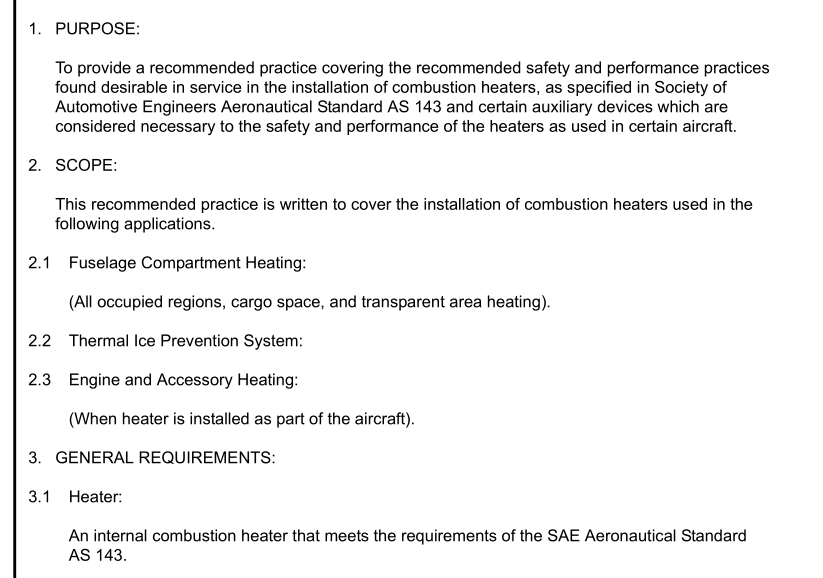SAE ARP 266A:2001 pdf download Installation, Heaters, Airplane, Internal Combustion Heater Exchanger Type
1. PURPOSE:
To provide a recommended practice covering the recommended safety and performance practices found desirable in service in the installation of combustion heaters, as specified in Society of Automotive Engineers Aeronautical Standard AS 143 and certain auxiliary devices which are considered necessary to the safety and performance of the heaters as used in certain aircraft.
2. SCOPE:
This recommended practice is written to cover the installation of combustion heaters used in the following applications.
2.1 Fuselage Compartment Heating:
(All occupied regions, cargo space, and transparent area heating).
2.2 Thermal Ice Prevention System:
2.3 Engine and Accessory Heating:
(When heater is installed as part of the aircraft).
3. GENERAL REQUIREMENTS:
3.1 Heater:
An internal combustion heater that meets the requirements of the SAE Aeronautical Standard AS 143.
3.2 Materials and Workmanship:
3.2.1 The installation should be made with materials throughout which are considered acceptable for the particular use intended and should be made and furnished with a degree, uniformity, and grade of workmanship generally accepted within the aircraft industry.
3.2.2 Consideration should be given for ducting, shrouding, insulation, and connections in the immediate vicinity of the heater to assure a minimum fire hazard from the installation.
3.2.3 Any material or sealing compounds should be free from smoke and not be susceptible to ignition under highest temperatures that can be expected during any operation of the heater which would not cause the heater to be shut down. Insulation exposed to hydraulic oil should be treated to avoid wicking action, which would result in a smoke or fire hazard.
3.3 Design Features:
3.3.1 To prevent a heater from overheating either itself, the discharge air, or the surrounding structure, the desirable practice is to provide a ventilating airflow across the heat exchanger in a quantity that will not allow excessive temperatures with the normal temperature control equipment inoperative.
3.3.2 The sealing materials on the duct work should be so installed that the inadvertent flowing of the sealant will not result in clogging of the air passages and subsequent high temperatures. The duct work joints should be so designed that airflow restrictions cannot occur. It should not be possible for inflammable materials to receive excessive heat by radiation or conduction, thereby causing ignition.
3.3.3 The installation should be such that all of the equipment will operate within normal ranges of power, fuel, air supply, and specified leakage of the system.
3.3.4 When used in the system supplying heat to a pressurized cabin, the heater system should not be adversely affected by the failure of the cabin pressurizing system. In such case an alternate to ram air or blower supplied source should be available for the operation of the heating system.
3.3.5 The heater should be readily installable in the airplane and in such a manner that it may be readily accessible for inspection, service, and removal.
SAE ARP 266A:2001 pdf download
